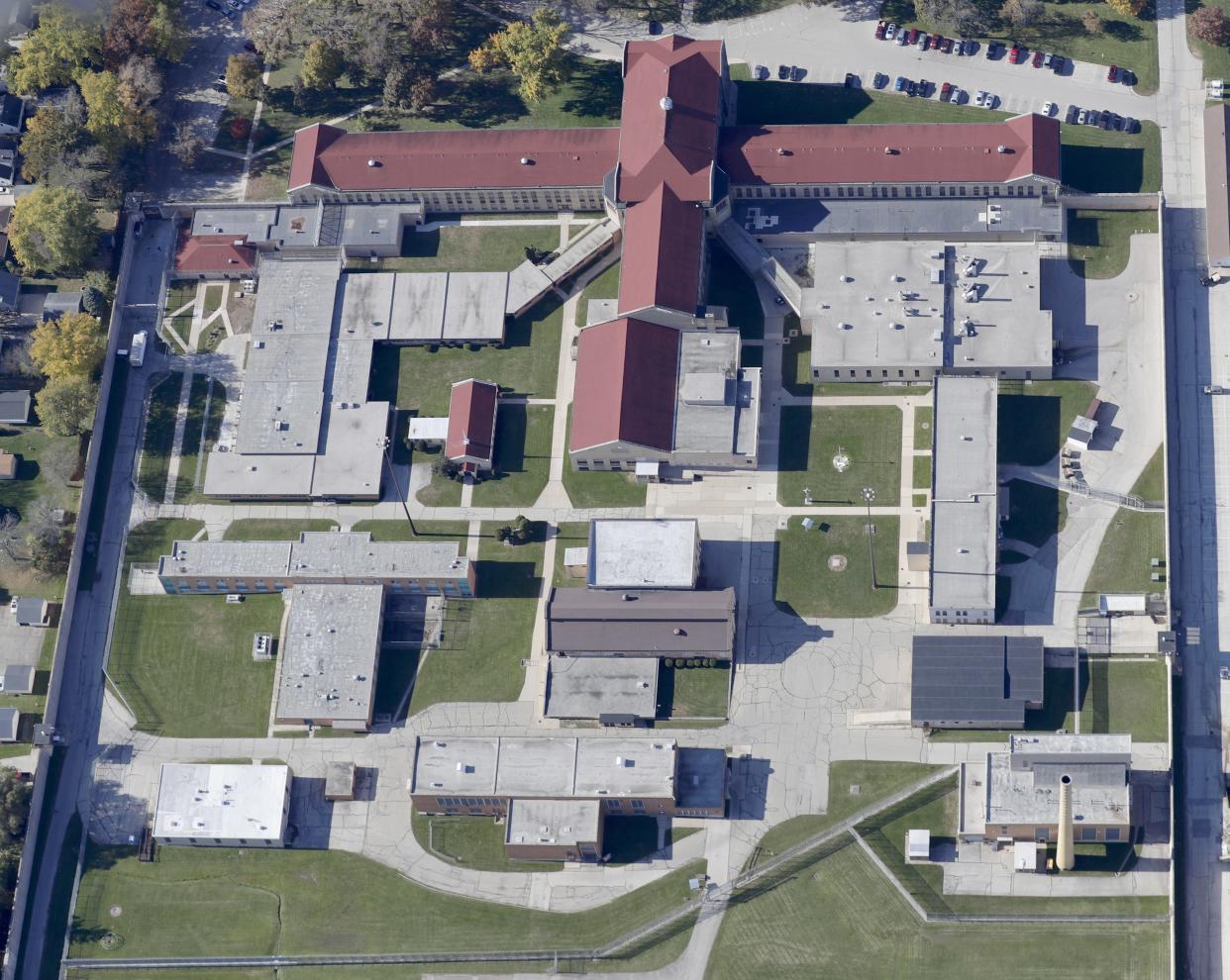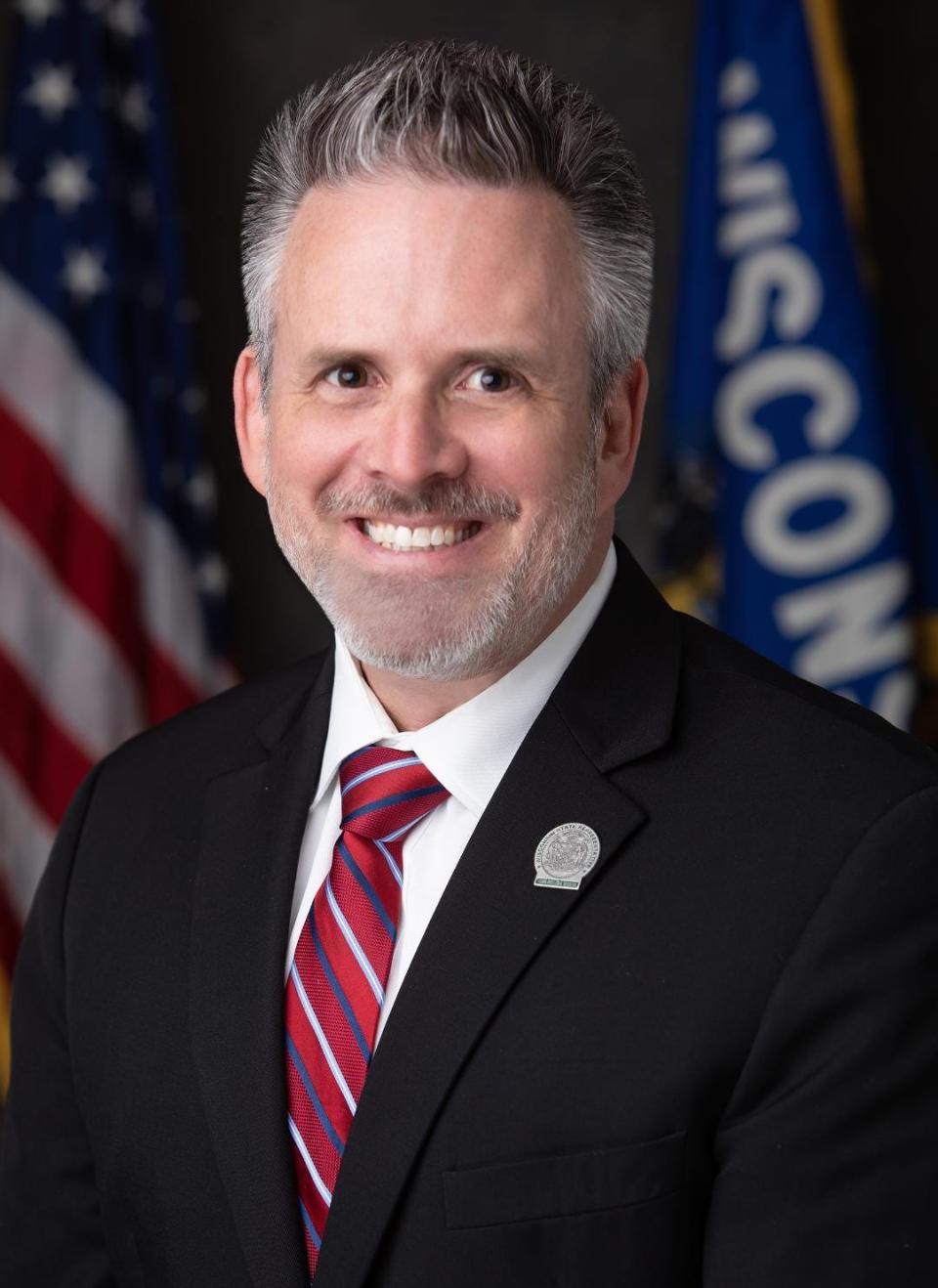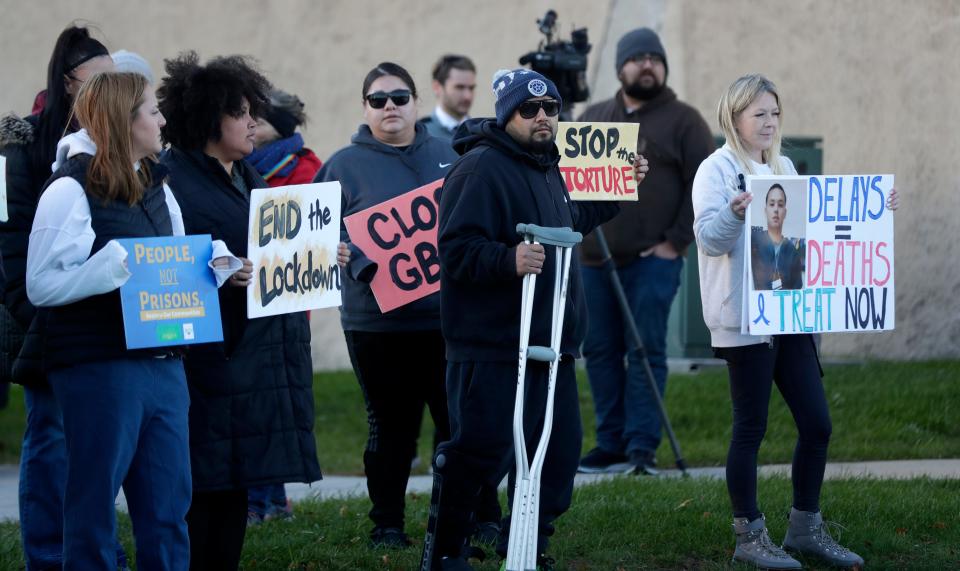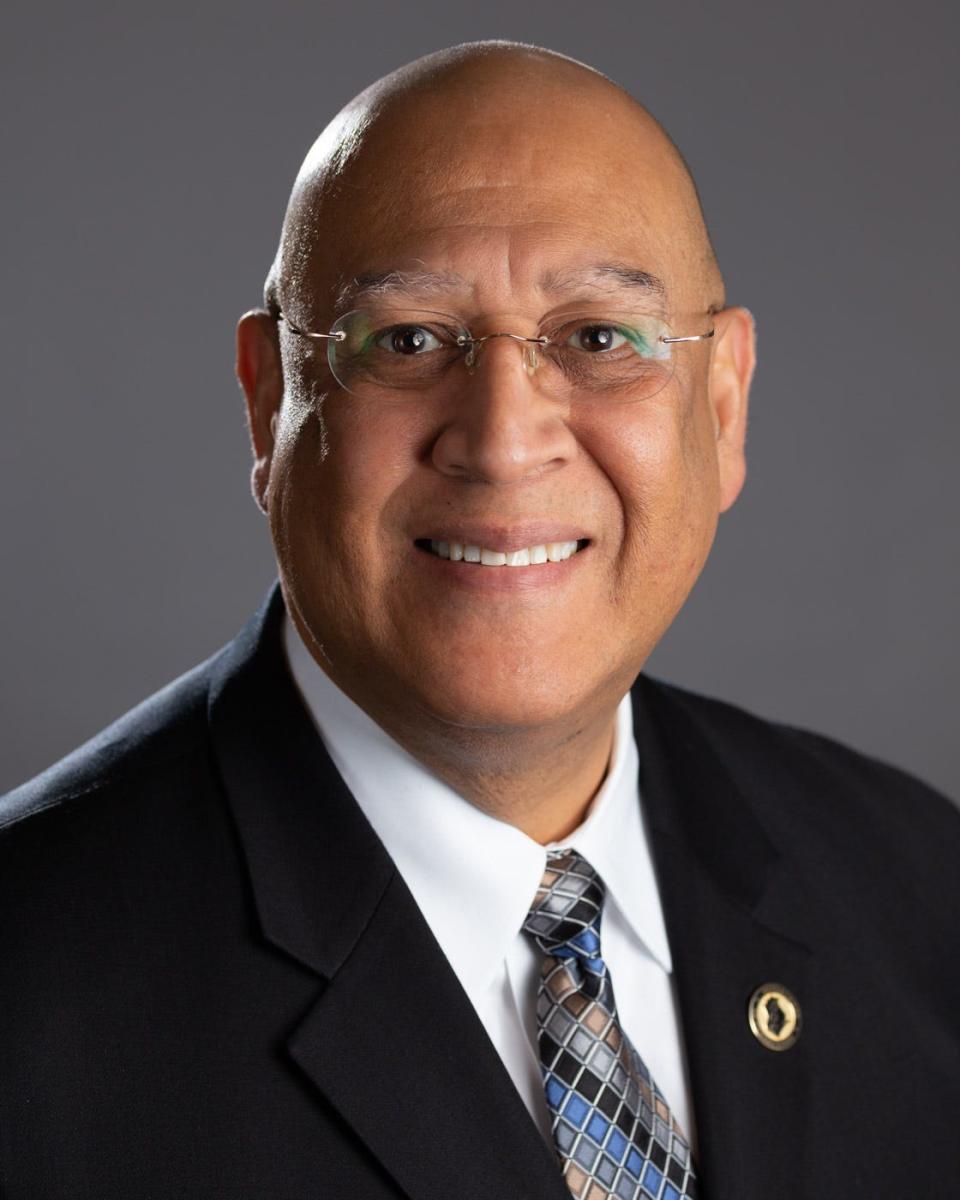How do you close a maximum-security prison? As debate over Green Bay's prison roils, experts weigh in.

- Oops!Something went wrong.Please try again later.
ALLOUEZ – Before he ever stepped foot in Green Bay Correctional Institution, Dant'e Cottingham, then 17, had already heard rumors about the prison nicknamed "Gladiator School."
"It was a place known to be gang-infested, violence-infested, nasty COs (correctional officers). It had a reputation before you even got there, so you knew what to expect," Cottingham said. "I was met with exactly what I heard. And then, I was surprised by a couple things, as well."
Cottingham said he entered a prison coated in ancient-looking rust. As he moved through Green Bay Correctional Institution, beat-up, corroded doors caught his eyes. For at least the first month of his stay, called "orientation," he lived in isolation where he could do nothing but stare at a wall, only leaving his room about three times a week to go to recreation and to shower every other day. The year was 1995, and the longer Cottingham stayed there, the worse the prison conditions got.
In the last few years, reports of rodent infestations, poor ventilation, broken toilets, tiny cells, and severe overcrowding have surrounded discussions about what should be done with Green Bay Correctional Institution, Wisconsin's second-oldest prison, which opened in 1898.
The facility over the years has been the scene of lockdowns that have kept people stewing in 7-by-8 foot cells on a nearly 24-hour basis since June, and hundreds of assaults between staff and prisoners.
By its own admission, Wisconsin's Department of Corrections noted many of the facility's problems can be explained by age and antiquated prison design, according to a 2020 report commissioned by the Governor's Committee on Correctional Facilities Assessment.
The 10-year master facilities assessment noted that, because the prison was constructed in a "different era of prison design," fire safety, accessibility and building codes were not primarily considered. Modern standards that emphasize the safe and humane treatment of inmates didn't yet exist.
"Age has resulted in failing infrastructure systems throughout the institution that require constant upkeep and costly modernization whenever possible," the report states.
These issues have been further magnified by the number of Green Bay's prison staff, who hobble by on a 40% vacancy rating.
"It is not a place where people want to work. It is a dark, dirty, broken place," said state Rep. David Steffen, R-Howard, who has been one of the biggest voices for closing the prison.

Steffen is among the officials pushing to close the antiquated prison, which cost taxpayers $44.8 million in the 2023 fiscal year. Republican and Democratic lawmakers in the surrounding areas have both signed letters in support of the facility's closure, as have Allouez Village Board President Jim Rafter, Brown County Executive Troy Streckenbach, Green Bay Mayor Eric Genrich and other local officials.
Meanwhile, in an email Tuesday, Gov. Tony Evers' spokesperson Britt Cudaback said the governor "has been clear that any plan to close the Green Bay Correctional Institution must be comprehensive and considered holistically based on the needs of Wisconsin’s adult corrections program."
Cudaback said the governor expects any plans to have "broad, bipartisan support."
So, what would closing Green Bay Correctional Institution actually entail, and why is it so difficult? How did other states do it, and what can Wisconsin learn from them? And even if it were approved today, how long before a new one would actually open?
Other states closed prisons by reducing the prison population
The state of California recently closed four of its prisons, the result of a huge reduction in inmate population between 2006 and now. Between sentencing reforms and a surge of releases connected to the pandemic, prison population decreased by 42%, according to the nonprofit news organization Cal Matters.
Similarly, New York has closed more than a dozen prisons due to criminal justice reform efforts that reduced the prison population to numbers not seen since 1984, according to The New York Times.
That's not the case in Wisconsin, where the number of people being sentenced to prison on a yearly basis has trended back up since COVID-19.
For every 100,000 people, Wisconsin incarcerates 663 people, which is nearly double the rate incarcerated in New York and 21% higher than California, according to the nonprofit organization Prison Policy Initiative.
As a result, most of Wisconsin's prisons are overcrowded. Green Bay Correctional Institution is designed to incarcerate 749 people but is currently housing nearly 1,000 people, which has led to double-bunking in cells approximately 56 square feet — 7-foot-by-8-foot rooms.
Kenneth Streit, a clinical professor emeritus at the University of Wisconsin Law School who has been involved with Wisconsin's corrections programs for more than 40 years, said it would be extremely unlikely for the state to close one of its prisons without first addressing violent crimes.
"Closing prisons without first reducing gun-related homicide and injury will never happen in Wisconsin," Streit said, noting that New York was able to release thousands of older incarcerated men when it eliminated its 1970s-era drug sentencing laws.
Both Evers and Department of Corrections Secretary Kevin Carr have previously pledged to reduce the prison population, but that hasn't happened. Plus, it's a hard sell for voters, Streit said, even though a majority of prison admissions are for less than five years.
"There is a substantial percentage with sentences of 20 or more years that, due to the severity, the vast majority of voters wouldn't approve," Streit said. "It would be hard for Evers or most Democrats to advocate early releases, which would be necessary to reduce prison levels if there was no change in crime rates."
Cudaback, Evers' spokesperson, said the governor has also pushed over the past five years to close the Lincoln Hills and Copper Lake juvenile facilities to "relieve pressure on our other adult institutions," but Republicans have obstructed the plans.
Cottingham doesn't believe the problem of mass incarceration will be remedied by building a modern prison, although he is a strong believer in closing Green Bay Correctional Institution.
"That idea is analogous to, if you're killing someone with a rusty knife, you should do it with a clean one," said Cottingham, who, since his release in 2022, has joined Ex-Incarcerated People Organizing and now serves as its interim associate director.
He said Wisconsin needs to dramatically reform its criminal justice system, which has some of the nation's toughest community supervision rules.
In fact, the top driver of incarceration in Wisconsin is not people committing new crimes, according to a new report from Wisconsin Policy Forum. Instead, it's people getting their community supervision revoked due to rules violations.
Those revocations accounted for about 30% of new prison admissions in Wisconsin from 2000 until 2020.
"It makes absolutely no sense to build a new prison when there are thousands of men being incarcerated for those reasons," Cottingham said.
Report says 30% of Green Bay Correctional Institution needs replacement
David Robillard, a retired architect and strategic planner who lives in Allouez, has been working with Rafter over the years to draft strategic plans for Green Bay Correctional Institution's future. He got to know the facility well when he designed the new visitors center, which opened in 2018.
When he first scoured the prison to determine the best spot to put the new center, he discovered the prison's "hidden jewels," an ironic term Robillard uses to describe the facility's costly infrastructure issues.
To his surprise and confusion, he learned the 19th-century prison has been rated a 1 — not suitable for programmed use — by the American Correctional Association, International Building Code, and the American Disabilities Association, according to the 2020 facilities assessment.
"It's a little confusing to me how the state of Wisconsin is not called on by American Correctional Association for not meeting standards. Every prison I've designed, boy, you better have that to the T," Robillard said.
Though Robillard is careful not to analyze beyond his field of expertise, it's his experience that simply renovating the facility "will not cut the mustard."
Robillard isn't the only expert who's reached this conclusion. Over the years, the state has paid two independent architectural and engineering firms to study the facility.
According to the study from 2018 by Minnesota-based architects BWBR and consulting engineers Mead & Hunt, nearly 30% of the prison needs replacement, including three major buildings that house prisoners, two of which are nearly a century old.
Almost half of the prison needs major work. Only 5% needs none.
Closure of Kansas prison offers parallels
Kansas State Penitentiary, known in modern days as Lansing Correctional Facility, offers parallels to Green Bay Correctional Institution. The 2017 Kansas Legislature authorized construction of new units at the Civil War-era prison, the oldest correctional facility in the state at the time.
Following a 20-year lease-purchase agreement of $362.2 million for construction, the state completed its build in 2020 and shut down the older facility. The final product was a 1,920-bed medium- and maximum-security unit and a 512-bed minimum security unit.
Similar to Green Bay Correctional institution, the older prison spent far too much money on renovations at the expense of safety and security, said Kansas state Rep. Stephen Owens, who chairs the Kansas House Committee on Corrections and Juvenile Justice.
The decision to close the old prison took years of bipartisan discussion, Owens said, driven by representatives in Kansas "wanting to be good stewards with taxpayer funds."
Kansas' prisons also struggled with overcrowding, which got to a point where the state started shipping incarcerated people to other states, Owens said.
"It was requiring significant amount of investment financially just to keep the water running and the pipes moving," Owens said. "You reach a point, when it comes to those older facilities, that you're spending so much money just to keep it open."
What would it cost to keep Green Bay Correctional Institution open?
Carr, the corrections secretary, has previously acknowledged that Green Bay Correctional Institution is more expensive to operate than a modern facility due to its need for regular upkeep and repairs.
In addition to significant housing renovations, the facility needs a new health services building, recreation area, kitchen and dining, administration, shipping and receiving, and a public lobby, according to the 2020 facilities report.
Simply upgrading the prison likely isn't an option, according to the report, which said the process would be "difficult, disruptive and costly."
DOC spokesperson Kevin Hoffman noted in an email that the 10-year facilities report "is just a snapshot and does not prioritize projects."
Rafter, the Allouez Village Board president, has been involved in the campaign to close Green Bay Correctional Institution for the last eight years. His purpose in the beginning was to open the area up for economic development because the prison sits on some of the most valuable property in Brown County.
In the process of having conversations with Steffen, along with families and advocates over the years, Rafter has learned a lot more.
"It needs well over $100 million — and by some estimates, $200 million — just to get it up to code and make it inhabitable," Rafter said. "That's a very scary thing. We have a thousand people living in there right now when it's literally falling apart."

Already, Wisconsin taxpayers fund one of the largest state prison budgets in the nation, spending about $220 per person per year to fund the prison system, according to Wisconsin Policy Forum.
Both Steffen and Rafter have been told by former prison guards that Green Bay Correctional Institution is a "tinderbox" due to the failing infrastructure systems responsible for water, fire protection, electricity, plumbing and temperature control. Many see the prison's closure as an inevitability.
"The reality is, the building is going to close, whether it's going to be by our choice or because of some sort of catastrophic failure," Steffen said. "Certainly, if we can control the timeline, we have better options in place. But if there is some major operational structural issue that causes that facility to have an emergency closure, there isn't a plan B."
Architects BWBR and consulting engineers Mead & Hunt estimated in 2018 that replacing the prison could cost taxpayers anywhere from $450 to $500 million.
Criminal justice reform advocates like Cottingham may not want to see a bigger prison imposed by the state, but to Rafter and Steffen, if incarcerated people had more room to rehabilitate, that may reduce recidivism.
Steffen said a new prison would have more space for vocational training, like the masonry program, which he says operates in a small room and has a two-year waitlist.
What would opening a new prison entail, and how long would it take?
According to the Wisconsin Department of Administration, construction of additional correctional facilities is subject to approval by the state Building Commission, which includes the governor, three state senators and three state representatives, and the state Legislature's 16-member Joint Committee on Finance.
If stakeholders really want to close Green Bay Correctional Institution, Robillard says the next step is a discussion about the opportunities and constraints of each of the correctional facilities analyzed in the 2020 report.
"It's about coming to the table as a team to really, truly have a discussion, one that isn't in silos," Robillard said. "Discussions may be happening but, God help everyone, nobody's talking to each other."
That means building a unified task force that includes representatives from the prison, the American Corrections Association, the Department of Corrections, and contractors. In Robillard's experience, that process can take anywhere from six to eight months — but it can be longer, depending on myriad variables. From there, construction drawings can take another year and a half.
Once the team gets talking, the work of site selection can begin, which can also be a time-consuming process involving many environmental, financial and political considerations, according to Robillard.
Another factor is workforce needs. Owens, the state representative from Kansas, said that opening the new Lansing Correctional Facility didn't lead to more correctional officers. Instead, modern technologies reduced staff requirements by about 40%, allowing everything from electronic doors and computer systems to streamline the work and increase the safety of officers.
"New facilities are designed with technology and movement of inmates and staff in mind, and that results in dramatic benefits," Steffen said.
When Republican lawmakers grilled Carr about the aging facility in March, the corrections secretary said closing the maximum-security prison would require other prisons to have vacancies. But many of Wisconsin's maximum- and medium-security facilities are too crowded and understaffed to absorb additional prisoners.

Since his appointment by Evers, Carr has instead pushed for the state to reduce prisoner numbers.
"We lock up too many people for too long at too high a cost to taxpayers, and with not enough in the way of results," Carr told the Green Bay Press-Gazette in 2019. "We believe we can reduce the population in a way that maintains public safety."
Previous attempts to close the prison have been unsuccessful.
Steffen introduced a bill in 2017 to replace Green Bay Correctional Institution with a privately built, state-run prison. The bill stalled after a number of lawmakers objected to the idea of leasing a prison from a private company. Others questioned the cost, estimated at $300 million to $500 million.
"If we can find a way where we have better results, that's safer for both inmates and workers, and long-term that provide savings to the taxpayer, I'm not sure how anyone can continue to be against it," Steffen said.
Natalie Eilbert covers mental health issues for USA TODAY NETWORK-Wisconsin. She welcomes story tips and feedback. You can reach her at neilbert@gannett.com or view her Twitter profile at @natalie_eilbert. If you or someone you know is dealing with suicidal thoughts, call the National Suicide Prevention Lifeline at 988 or text "Hopeline" to the National Crisis Text Line at 741-741.
This article originally appeared on Green Bay Press-Gazette: Closing Green Bay Correctional Institution could cost up to $500 million

